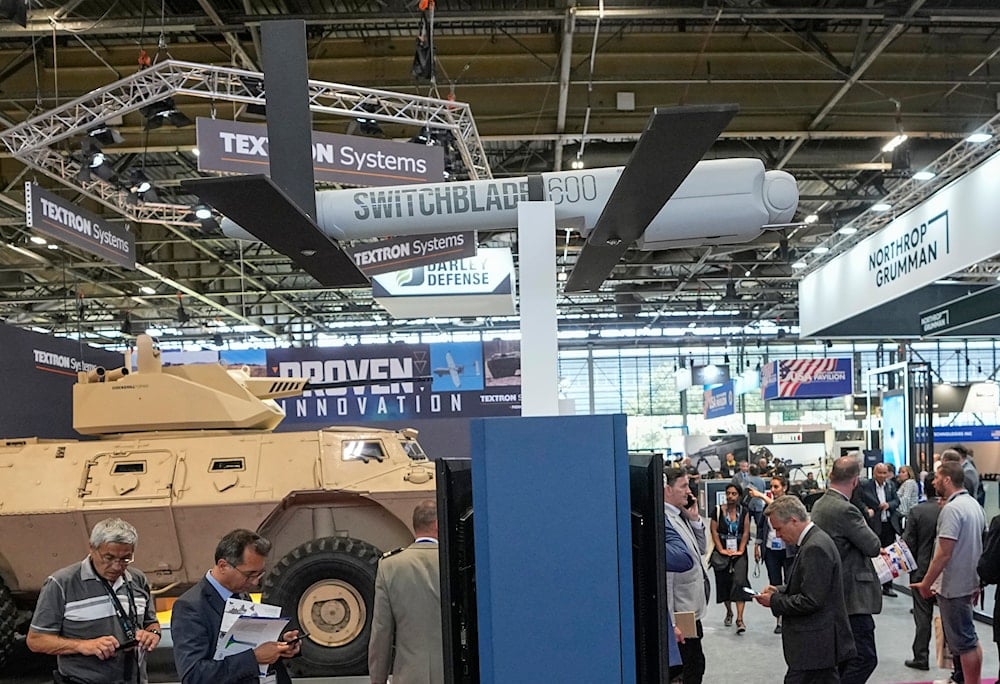Pentagon’s AI fleet, set to counter China, faces setbacks: WSJ
The Pentagon’s Replicator program to deploy autonomous drones by 2025 is falling behind, facing cost overruns, tech failures, and organizational changes.
-

A Switchblade 600 loitering missile drone manufactured by AeroVironment is displayed at the Eurosatory arms show in Villepinte, north of Paris, on June 14, 2022 (AP)
A plan by the Pentagon to prepare for a potential conflict with China by fielding thousands of advanced drones has failed to meet its goal, and the military has struggled to figure out how to use some of the systems, sources familiar with the matter told The Wall Street Journal.
This effort was launched two years ago to quickly buy low-cost autonomous weapons and counter China's growing military capabilities, according to the source, but it is now being moved to a new organization because of concerns that it is not moving fast enough.
This move shows frustration with the setbacks in the Replicator program, a key effort for the Biden administration's Pentagon that aimed to field thousands of air, land, and sea-based AI systems by August 2025, a program that then-Deputy Defense Secretary Kathleen Hicks announced in 2023 by promising technology that would be small, smart, and cheap.
Although Deputy Secretary Hicks requested $1 billion for the Replicator program over two years, some lawmakers are pushing for billions of dollars in additional spending because they argue the total amount needs to be much higher to guarantee the program's success.
Replicator program trips over delays, late deliveries
According to WSJ's sources, some Replicator systems have been unreliable or were too expensive and slow to manufacture, which prevented them from being purchased in the necessary quantities.
The Pentagon has also had difficulty finding software that can effectively control large numbers of drones from different manufacturers as they work together to locate and potentially attack a target, which is a key requirement for making the Replicator vision function.
In an effort to accelerate the program and focus on the most appropriate weapons, the Pentagon leadership has moved the Replicator work to a new division under Special Operations Command called the Defense Autonomous Warfare Group, or DAWG.
People involved in Replicator give different reasons for the delays but still consider the effort mostly successful, with some blaming the military services for pushing to buy systems that were not ready and others arguing that the setbacks are a normal part of any ambitious attempt to fast-track new technology.
In an email, Hicks stated that the Replicator program was on track for success when she left the Pentagon in late January and that it had jump-started the process of buying autonomous systems for the military.
Showcases marred with failures
A defense official said that Lt. Gen. Frank Donovan, the vice commander of Special Operations Command, is now overseeing Replicator. When he took over the program in August, he attended a California event meant to showcase its advanced technology, but participants said the event instead highlighted that the systems were not yet ready.
An unmanned boat from BlackSea Technologies had a rudder failure and drifted off, the launch of an Anduril Industries aerial drone was delayed by a potential issue with its launch tubes, and the software on several boats misidentified or failed to identify objects as intended.
“There were very, very good things that happened from Replicator,” Palmer Luckey, founder of Anduril, told WSJ, “Could it have been done better? Could it have been more clear about what exactly they were doing? Yes, of course. But big picture, I don’t think it was that bad."
Three of the approximately twelve autonomous systems chosen for Replicator were either unfinished or still just a concept at the time of their selection, WSJ sources familiar with the matter stated. Officials noted that among Replicator's shortcomings, the Defense Innovation Unit was instructed to purchase drones with older technology and did not rigorously test the platforms and software before acquiring them.
Ineffective acquisitions
According to sources, one error was buying hundreds of BlackSea's GARC unmanned boats, which are not designed for complex Pacific missions. Navy officers reportedly pushed for them without understanding their technical limits, and repeated software changes led to rising costs and setbacks.
One of the largest Replicator acquisitions was the Switchblade 600 drone, a system that had already struggled to perform effectively in Ukraine, and an analysis from an Army intelligence center suggested the Switchblade would be vulnerable in environments where communications are jammed, which is a common feature of modern conflicts.
The Switchblade costs about $100,000, which is ten times more than the small drones used by Ukrainian and Russian forces. AeroVironment states that its aircraft's capabilities are far greater than a typical cheap drone because it can destroy large air defense or missile launching systems, a performance that justifies the price.
Integrating the technology was also difficult, as demonstrated during last year's Project Kahuna exercise in the Pacific, where drones from various manufacturers, connected by Anduril's software, had trouble coordinating and performing tasks when they moved out of the operator's line of sight.

 5 Min Read
5 Min Read








